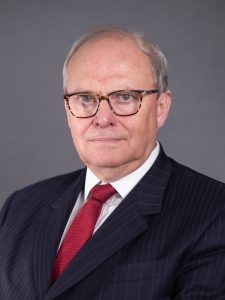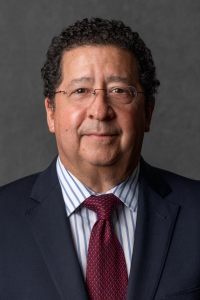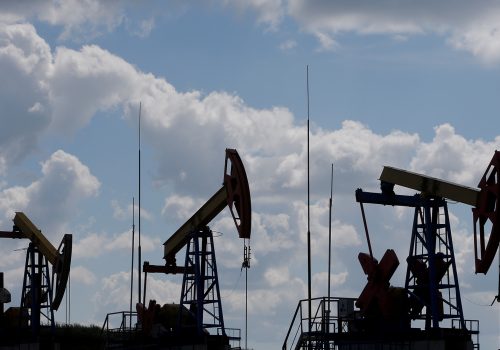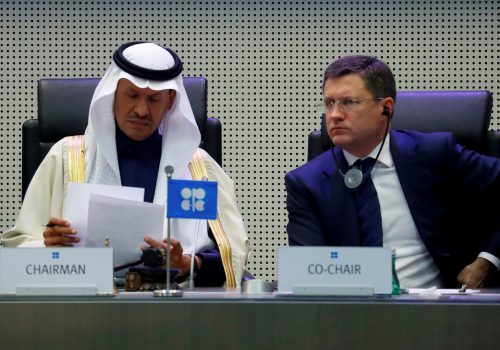An unprecedented crisis in the oil market is looming. With demand in free-fall, a price war bringing oil prices to multi-decade lows, and a flood of oil supplies overwhelming available storage, a consensus to take action is emerging – but the parties have struggled to agree about what type of action and by whom. As the Organization of the Petroleum Exporting Countries (OPEC) concludes an extraordinary meeting of OPEC and non-OPEC members and Saudi Arabia hosts an emergency meeting of the G20, the intersection of energy markets and geopolitics is shaping how the global community responds to the oil market crisis (and whether it is enough). What emerges from these four days will have a transformative effect on the market long after the coronavirus passes.
Event recap
On April 13, 2020, the Atlantic Council Global Energy Center hosted a conversation with leading experts on the implications of the April 12 OPEC+ deal to cut oil production by 9.7 million barrels per day (bpd). This discussion was moderated by Randolph Bell, director of the Global Energy Center and Richard Morningstar chair for global energy security. Following introductory remarks, the moderator was joined by Anders Åslund, senior fellow at the Atlantic Council Eurasia Center, Helima Croft, managing director and global head of commodity strategy at RBC Capital Markets; Kirsten Fontenrose, director of the Atlantic Council Scowcroft Middle East Security Initiative; David Goldwyn, president of Goldwyn Global Strategies and chair of the Atlantic Council Energy Advisory Group; and Robert J. Johnston, managing director for energy, climate, and natural resources & executive adviser at the Eurasia Group.
RUSSIA-SAUDI ANGLE
The conversation began with an overview of the agreement and implications for key countries that agreed to oil production cuts. Anders Åslund began by commenting on internal deliberations in the Kremlin, noting that much of the Russian government had mobilized around the idea of production cuts, and that Igor Sechin, CEO of Rosneft, was the dominant voice throughout March and into April. Finally, on April 3, Russian President Vladimir Putin held a public meeting with Energy Minister Alexander Novak to make clear Russia was interested in an OPEC+ oil production agreement. When asked about the probability of Russia reneging on the deal over the course of the year, Åslund and David Goldwyn expressed slightly different views. Åslund asserted that it would ultimately depend on where the oil price landed, while Goldwyn stated that Putin would not allow Sechin to make the same mistake twice. Saudi Arabia had come out as the ultimate winner, likely with the understanding that it could offer discounts to undercut Russia if Putin did not adhere to the terms of the deal.
US ROLE IN NEGOTIATIONS
The role of the United States—and the extent to which the Trump administration pushed certain countries across the finish line with their respective production cuts—featured prominently in panelists’ remarks. Kirsten Fontenrose, addressing US-Saudi negotiations, noted that Trump was in a better position to negotiate with Saudi Arabia over production cuts than—for example—Saudi Arabia’s war in Yemen. Given the current COVID-19 crisis, the president could threaten to remove US troops from Saudi Arabia in a way that would both elicit political support from his base (given already low demand for fossil fuels) and publicly lend support to the shale industry. While Fontenrose suggested that the Trump administration played an important role in the Kingdom’s agreement to production cuts, Helima Croft reminded audience members that the Saudis had been pushing for these cuts since the end of February. Croft further noted that given heavy Saudi investment in the US shale industry, the Kingdom was unlikely to be motivated by a desire to crowd US shale out of the market.
NORTH AMERICAN PRODUCTION
Analysis of North American production also featured prominently throughout the call. David Goldwyn, assessing Mexico’s refusal to cut production by 400,000 bpd, relayed the economic, political, and diplomatic motives that resulted in the country’s ultimate 300,000 bpd production cut. Mexico’s state-owned petroleum company, Pemex, is continuing to build refineries despite its approximately $100 billion debt. Even though a 400,000 bpd production cut was not disproportionate to cuts expected by countries like Angola or Nigeria, the expectation was significant given Mexico’s struggle to reach 1.7 million bpd in March. Economic factors linked to Pemex’s shrinking production, paired with Mexican President Andrés Manuel López Obrador’s nationalist platform and declining popularity, fueled resistance to production cuts. While Mexico may have scored a short-term win, it remains to be seen how President Trump will cash in on his defense of Mexico’s 300,000 bpd production cut.
In response to a question about Canada’s role in the G20 negotiations, Robert Johnston noted that given Canada’s role as a higher-cost producer with little pipeline capacity, the OPEC+ deal allowed the country to avoid what could have otherwise resulted in an oil storage shutdown in six to eight weeks. He evaluated prospects for a “new normal” of OPEC+, in which producers from OPEC, OPEC+, and the G20 nations (or OPEC++) were divided into four blocks: the North American block comprised of the United States, Canada, and Mexico; the OPEC countries; Russia as a stand-alone player; and a fourth made up of the remaining (smaller) oil-producing countries. Johnston, Goldwyn, and Croft all weighed in on the implications of this new normal, ultimately agreeing that the negotiation process revealed a mutual dependence between US shale producers and major oil producers in the Middle East.
Addressing implications for US shale, Goldwyn noted that companies that could not survive a $20-30/barrel environment caught a breather but are ultimately headed for restructuring, as shale producers Chesapeake Energy and Whiting Petroleum indicate. Furthermore, future bailouts are unlikely to provide specific provisions for the shale industry, as market forces will likely allow international oil companies (IOCs) to survive even as smaller producers are forced to consolidate. Johnston added that given the resilience and short-cycle nature of shale projects, even if storage did fill up and wells needed to be closed temporarily, they could be turned back on quite easily.
IMPLICATIONS FOR SMALLER PRODUCERS
Turning to implications for smaller and less stable producers across the Middle East, Africa, and South America, panelists discussed the extent to which certain producers would be able to adapt and retain investment in the wake of the current production crisis and longer-term trends toward clean energy. Fontenrose discussed the case of Iraq in particular, which she claimed would struggle with a 23 percent (or 1 million bpd) cut in production. Fontenrose suggested that OPEC could tie production cut requirements to World Bank liquefied natural gas (LNG) reform implementation, or the United States could tie waivers in Iraq’s importation from Iran to such benchmarks. Without some sort of deal related to LNG reform, Iraq would struggle to meet its budget needs.
Johnston and Goldwyn discussed opportunities and challenges for producers in Africa and South America. While Brazil could likely survive the current price environment, Goldwyn asserted, less stable countries like Angola or Nigeria would need to adapt to mitigate risk for investors. As demand increases, risk tolerance among investors decreases. Large companies considering twenty-to-thirty-year time horizons will likely be willing to invest in places that offer large-scale, low-unit cost projects like Guyana, Mozambique, and Brazil, but countries like Iraq and Nigeria would have a much harder time attracting the same investment, given investor perceptions of long-term instability.
Johnston offered an alternative view, arguing that countries like Brazil, Mexico, and even Canada were struggling before the COVID-19 crisis and would likely have trouble attracting investment for long-cycle projects. Given the current price environment, prospects for green stimulus in European and Asian countries, and the general shift toward clean energy among G20 nations, investment will increasingly turn away from traditional fossil fuels and toward renewables.
Panelists concluded the discussion with outstanding questions related to the aftermath of the negotiations. Topics to watch included the future of Russian investment in Libya and Africa, state-level regulation in the United States, and the emergence of side deals that contributed to ultimate production cuts.
A conversation with
Anders Aslund
Senior Fellow, Eurasia Center
Atlantic Council
Helima Croft
Managing Director and Global Head of Commodity Strategy
RBC Capital Markets
Kirsten Fontenrose
Director, Scowcroft Middle East Security Initiative
Atlantic Council
David Goldwyn
Chair, Energy Advisory Group
Atlantic Council
Robert J. Johnston
Managing Director, Energy, Climate, and Natural Resources & Executive Advisor
Eurasia Group
Moderated by
Randolph Bell
Director, Global Energy Center and Richard Morningstar Chair for Global Energy Security
Atlantic Council
Related Experts
Related content
Learn more about the Global Energy Center

The Global Energy Center develops and promotes pragmatic and nonpartisan policy solutions designed to advance global energy security, enhance economic opportunity, and accelerate pathways to net-zero emissions.







